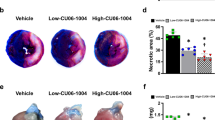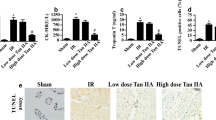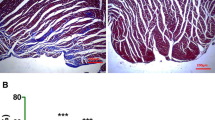Abstract
Microvascular obstruction (MVO) and leakage (MVL) forms a pivotal part of microvascular damage following cardiac ischemia–reperfusion (IR). We tested the effect of relaxin therapy on MVO and MVL in mice following cardiac IR injury including severity of MVO and MVL, opening capillaries, infarct size, regional inflammation, cardiac function and remodelling, and permeability of cultured endothelial monolayer. Compared to vehicle group, relaxin treatment (50 μg/kg) reduced no-reflow area by 38% and the content of Evans blue as a permeability tracer by 56% in jeopardized myocardium (both P < 0.05), effects associated with increased opening capillaries. Relaxin also decreased leukocyte density, gene expression of cytokines, and mitigated IR-induced decrease in protein content of VE-cadherin and relaxin receptor. Infarct size was comparable between the two groups. At 2 weeks post-IR, relaxin treatment partially preserved cardiac contractile function and limited chamber dilatation versus untreated controls by echocardiography. Endothelial cell permeability assay demonstrated that relaxin attenuated leakage induced by hypoxia-reoxygenation, H2O2, or cytokines, action that was independent of nitric oxide but associated with the preservation of VE-cadherin. In conclusion, relaxin therapy attenuates IR-induced MVO and MVL and endothelial leakage. This protection was associated with reduced regional inflammatory responses and consequently led to alleviated adverse cardiac remodeling.







Similar content being viewed by others
References
Bani-Sacchi T, Bigazzi M, Bani D, Mannaioni PF, Masini E (1995) Relaxin-induced increased coronary flow through stimulation of nitric oxide production. Br J Pharmacol 116:1589–1594. https://doi.org/10.1111/j.1476-5381.1995.tb16377.x
Bani D, Bigazzi M, Masini E, Bani G, Sacchi TB (1995) Relaxin depresses platelet aggregation: in vitro studies on isolated human and rabbit platelets. Lab Investig 73:709–716
Bani D, Masini E, Bello MG, Bigazzi M, Sacchi TB (1998) Relaxin protects against myocardial injury caused by ischemia and reperfusion in rat heart. Am J Pathol 152:1367–1376
Beiert T, Knappe V, Tiyerili V, Stockigt F, Effelsberg V, Linhart M, Steinmetz M, Klein S, Schierwagen R, Trebicka J, Roell W, Nickenig G, Schrickel JW, Andrie RP (2018) Chronic lower-dose relaxin administration protects from arrhythmia in experimental myocardial infarction due to anti-inflammatory and anti-fibrotic properties. Int J Cardiol 250:21–28. https://doi.org/10.1016/j.ijcard.2017.09.017
Bekkers SC, Yazdani SK, Virmani R, Waltenberger J (2010) Microvascular obstruction: underlying pathophysiology and clinical diagnosis. J Am Coll Cardiol 55:1649–1660. https://doi.org/10.1016/j.jacc.2009.12.037
Botker HE, Hausenloy D, Andreadou I, Antonucci S, Boengler K, Davidson SM, Deshwal S, Devaux Y, Di Lisa F, Di Sante M, Efentakis P, Femmino S, Garcia-Dorado D, Giricz Z, Ibanez B, Iliodromitis E, Kaludercic N, Kleinbongard P, Neuhauser M, Ovize M, Pagliaro P, Rahbek-Schmidt M, Ruiz-Meana M, Schluter KD, Schulz R, Skyschally A, Wilder C, Yellon DM, Ferdinandy P, Heusch G (2018) Practical guidelines for rigor and reproducibility in preclinical and clinical studies on cardioprotection. Basic Res Cardiol 113:39. https://doi.org/10.1007/s00395-018-0696-8
Brecht A, Bartsch C, Baumann G, Stangl K, Dschietzig T (2011) Relaxin inhibits early steps in vascular inflammation. Regul Pept 166:76–82. https://doi.org/10.1016/j.regpep.2010.09.001
Carrick D, Haig C, Ahmed N, Rauhalammi S, Clerfond G, Carberry J, Mordi I, McEntegart M, Petrie MC, Eteiba H, Hood S, Watkins S, Lindsay MM, Mahrous A, Welsh P, Sattar N, Ford I, Oldroyd KG, Radjenovic A, Berry C (2016) Temporal evolution of myocardial hemorrhage and edema in patients after acute ST-segment elevation myocardial infarction: pathophysiological insights and clinical implications. J Am Heart Assoc 5:e002834. https://doi.org/10.1161/JAHA.115.002834
Collins MA, An J, Peller D, Bowser R (2015) Total protein is an effective loading control for cerebrospinal fluid western blots. J Neurosci Methods 251:72–82. https://doi.org/10.1016/j.jneumeth.2015.05.011
Conrad KP, Novak J (2004) Emerging role of relaxin in renal and cardiovascular function. Am J Physiol Regul Integr Comp Physiol 287:R250–R261. https://doi.org/10.1152/ajpregu.00672.2003
Dai W, Hale S, Kloner RA (2017) Delayed therapeutic hypothermia protects against the myocardial no-reflow phenomenon independently of myocardial infarct size in a rat ischemia/reperfusion model. Int J Cardiol 236:400–404. https://doi.org/10.1016/j.ijcard.2017.01.079
Dschietzig T, Brecht A, Bartsch C, Baumann G, Stangl K, Alexiou K (2012) Relaxin improves TNF-alpha-induced endothelial dysfunction: the role of glucocorticoid receptor and phosphatidylinositol 3-kinase signalling. Cardiovasc Res 95:97–107. https://doi.org/10.1093/cvr/cvs149
Du XJ (2018) Post-infarct cardiac injury, protection and repair: roles of non-cardiomyocyte multicellular and acellular components. Sci China Life Sci 31:266–276. https://doi.org/10.1007/s11427-017-9223-x
Du XJ, Bathgate RA, Samuel CS, Dart AM, Summers RJ (2010) Cardiovascular effects of relaxin: from basic science to clinical therapy. Nat Rev Cardiol 7:48–58. https://doi.org/10.1038/nrcardio.2009.198
Du XJ, Hewitson TD, Nguyen MN, Samuel CS (2014) Therapeutic effects of serelaxin in acute heart failure. Circ J 78:542–552. https://doi.org/10.1253/circj.CJ-14-0014
Eltzschig HK, Eckle T (2011) Ischemia and reperfusion—from mechanism to translation. Nat Med 17:1391–1401. https://doi.org/10.1038/nm.2507
Failli P, Nistri S, Quattrone S, Mazzetti L, Bigazzi M, Sacchi TB, Bani D (2002) Relaxin up-regulates inducible nitric oxide synthase expression and nitric oxide generation in rat coronary endothelial cells. FASEB J 16:252–254. https://doi.org/10.1096/fj.01-0569fje
Feng D, Nagy JA, Hipp J, Dvorak HF, Dvorak AM (1996) Vesiculo-vacuolar organelles and the regulation of venule permeability to macromolecules by vascular permeability factor, histamine, and serotonin. J Exp Med 183:1981–1986
Folino A, Losano G, Rastaldo R (2013) Balance of nitric oxide and reactive oxygen species in myocardial reperfusion injury and protection. J Cardiovasc Pharmacol 62:567–575. https://doi.org/10.1097/FJC.0b013e3182a50c45
Funaro S, Galiuto L, Boccalini F, Cimino S, Canali E, Evangelio F, DeLuca L, Paraggio L, Mattatelli A, Gnessi L, Agati L (2011) Determinants of microvascular damage recovery after acute myocardial infarction: results from the acute myocardial infarction contrast imaging (AMICI) multi-centre study. Eur J Echocardiogr 12:306–312. https://doi.org/10.1093/ejechocard/jer009
Gao XM, Liu Y, White D, Su Y, Drew BG, Bruce CR, Kiriazis H, Xu Q, Jennings N, Bobik A, Febbraio MA, Kingwell BA, Bucala R, Fingerle-Rowson G, Dart AM, Morand EF, Du XJ (2011) Deletion of macrophage migration inhibitory factor protects the heart from severe ischemia–reperfusion injury: a predominant role of anti-inflammation. J Mol Cell Cardiol 50:991–999. https://doi.org/10.1016/j.yjmcc.2010.12.022
Gao XM, Moore XL, Liu Y, Wang XY, Han LP, Su Y, Tsai A, Xu Q, Zhang M, Lambert GW, Kiriazis H, Gao W, Dart AM, Du XJ (2016) Splenic release of platelets contributes to increased circulating platelet size and inflammation after myocardial infarction. Clin Sci (Lond) 130:1089–1104. https://doi.org/10.1042/CS20160234
Gao XM, Wu QZ, Kiriazis H, Su Y, Han LP, Pearson JT, Taylor AJ, Du XJ (2017) Microvascular leakage in acute myocardial infarction: characterization by histology, biochemistry, and magnetic resonance imaging. Am J Physiol Heart Circ Physiol 312:H1068–H1075. https://doi.org/10.1152/ajpheart.00073.2017
Garlanda C, Parravicini C, Sironi M, De Rossi M, de Wainstok Calmanovici R, Carozzi F, Bussolino F, Colotta F, Mantovani A, Vecchi A (1994) Progressive growth in immunodeficient mice and host cell recruitment by mouse endothelial cells transformed by polyoma middle-sized T antigen: implications for the pathogenesis of opportunistic vascular tumors. Proc Natl Acad Sci USA 91:7291–7295. https://doi.org/10.1073/pnas.91.15.7291
Hale SL, Mehra A, Leeka J, Kloner RA (2008) Postconditioning fails to improve no reflow or alter infarct size in an open-chest rabbit model of myocardial ischemia–reperfusion. Am J Physiol Heart Circ Physiol 294:H421–H425. https://doi.org/10.1152/ajpheart.00962.2007
Hamirani YS, Wong A, Kramer CM, Salerno M (2014) Effect of microvascular obstruction and intramyocardial hemorrhage by CMR on LV remodeling and outcomes after myocardial infarction: a systematic review and meta-analysis. JACC Cardiovasc Imaging 7:940–952. https://doi.org/10.1016/j.jcmg.2014.06.012
Hausenloy DJ, Chilian W, Crea F, Davidson SM, Ferdinandy P, Garcia-Dorado D, van Royen N, Schulz R, Heusch G (2019) The coronary circulation in acute myocardial ischaemia/reperfusion injury: a target for cardioprotection. Cardiovasc Res 115:1143–1155. https://doi.org/10.1093/cvr/cvy286
Heusch G (2016) The coronary circulation as a target of cardioprotection. Circ Res 118:1643–1658. https://doi.org/10.1161/CIRCRESAHA.116.308640
Hirase T, Node K (2012) Endothelial dysfunction as a cellular mechanism for vascular failure. Am J Physiol Heart Circ Physiol 302:H499–H505. https://doi.org/10.1152/ajpheart.00325.2011
Hisaw FL, Zarrow MX (1950) The physiology of relaxin. Vitam Horm 8:151–178. https://doi.org/10.1016/S0083-6729(08)60670-6
Kloner RA (2011) No-reflow phenomenon: maintaining vascular integrity. J Cardiovasc Pharmacol Ther 16:244–250. https://doi.org/10.1177/1074248411405990
Lam M, Royce SG, Samuel CS, Bourke JE (2018) Serelaxin as a novel therapeutic opposing fibrosis and contraction in lung diseases. Pharmacol Ther 187:61–70. https://doi.org/10.1016/j.pharmthera.2018.02.004
Lindsey ML, Bolli R, Canty JM Jr, Du XJ, Frangogiannis NG, Frantz S, Gourdie RG, Holmes JW, Jones SP, Kloner RA, Lefer DJ, Liao R, Murphy E, Ping P, Przyklenk K, Recchia FA, Schwartz Longacre L, Ripplinger CM, Van Eyk JE, Heusch G (2018) Guidelines for experimental models of myocardial ischemia and infarction. Am J Physiol Heart Circ Physiol 314:H812–H838. https://doi.org/10.1152/ajpheart.00335.2017
Mewton N, Thibault H, Roubille F, Lairez O, Rioufol G, Sportouch C, Sanchez I, Bergerot C, Cung TT, Finet G, Angoulvant D, Revel D, Bonnefoy-Cudraz E, Elbaz M, Piot C, Sahraoui I, Croisille P, Ovize M (2013) Postconditioning attenuates no-reflow in STEMI patients. Basic Res Cardiol 108:383. https://doi.org/10.1007/s00395-013-0383-8
Moore XL, Su Y, Fan Y, Zhang YY, Woodcock EA, Dart AM, Du XJ (2014) Diverse regulation of cardiac expression of relaxin receptor by alpha1- and beta1-adrenoceptors. Cardiovasc Drugs Ther 28:221–228. https://doi.org/10.1007/s10557-014-6525-x
Ndrepepa G, Tiroch K, Fusaro M, Keta D, Seyfarth M, Byrne RA, Pache J, Alger P, Mehilli J, Schomig A, Kastrati A (2010) 5-Year prognostic value of no-reflow phenomenon after percutaneous coronary intervention in patients with acute myocardial infarction. J Am Coll Cardiol 55:2383–2389. https://doi.org/10.1016/j.jacc.2009.12.054
Nie X, Li C, Hu S, Xue F, Kang YJ, Zhang W (2017) An appropriate loading control for western blot analysis in animal models of myocardial ischemic infarction. Biochem Biophys Rep 12:108–113. https://doi.org/10.1016/j.bbrep.2017.09.001
Nistri S, Cinci L, Perna AM, Masini E, Mastroianni R, Bani D (2008) Relaxin induces mast cell inhibition and reduces ventricular arrhythmias in a swine model of acute myocardial infarction. Pharmacol Res 57:43–48. https://doi.org/10.1016/j.phrs.2007.11.001
Perna AM, Masini E, Nistri S, Briganti V, Chiappini L, Stefano P, Bigazzi M, Pieroni C, Bani Sacchi T, Bani D (2005) Novel drug development opportunity for relaxin in acute myocardial infarction: evidences from a swine model. FASEB J 19:1525–1527. https://doi.org/10.1096/fj.04-3664fje
Qin CX, May LT, Li R, Cao N, Rosli S, Deo M, Alexander AE, Horlock D, Bourke JE, Yang YH, Stewart AG, Kaye DM, Du XJ, Sexton PM, Christopoulos A, Gao XM, Ritchie RH (2017) Small-molecule-biased formyl peptide receptor agonist compound 17b protects against myocardial ischaemia–reperfusion injury in mice. Nat Commun 8:14232. https://doi.org/10.1038/ncomms14232
Reffelmann T, Kloner RA (2002) Microvascular reperfusion injury: rapid expansion of anatomic no reflow during reperfusion in the rabbit. Am J Physiol Heart Circ Physiol 283:H1099–H1107. https://doi.org/10.1152/ajpheart.00270.2002
Samuel CS, Cendrawan S, Gao XM, Ming Z, Zhao C, Kiriazis H, Xu Q, Tregear GW, Bathgate RA, Du XJ (2011) Relaxin remodels fibrotic healing following myocardial infarction. Lab Investig 91:675–690. https://doi.org/10.1038/labinvest.2010.198
Sarwar M, Du XJ, Dschietzig TB, Summers RJ (2017) The actions of relaxin on the human cardiovascular system. Br J Pharmacol 174:933–949. https://doi.org/10.1111/bph.13523
Skyschally A, Amanakis G, Neuhauser M, Kleinbongard P, Heusch G (2017) Impact of electrical defibrillation on infarct size and no-reflow in pigs subjected to myocardial ischemia–reperfusion without and with ischemic conditioning. Am J Physiol Heart Circ Physiol 313:H871–H878. https://doi.org/10.1152/ajpheart.00293.2017
Stark K, Pekayvaz K, Massberg S (2018) Role of pericytes in vascular immunosurveillance. Front Biosci (Landmark Ed) 23:767–781. https://doi.org/10.2741/4615
Valle Raleigh J, Mauro AG, Devarakonda T, Marchetti C, He J, Kim E, Filippone S, Das A, Toldo S, Abbate A, Salloum FN (2017) Reperfusion therapy with recombinant human relaxin-2 (serelaxin) attenuates myocardial infarct size and NLRP3 inflammasome following ischemia/reperfusion injury via eNOS-dependent mechanism. Cardiovasc Res 113:609–619. https://doi.org/10.1093/cvr/cvw246
van Nieuw Amerongen GP, van Hinsbergh VW (2002) Targets for pharmacological intervention of endothelial hyperpermeability and barrier function. Vasc Pharmacol 39:257–272. https://doi.org/10.1016/S1537-1891(03)00014-4
Vestweber D (2008) VE-cadherin: the major endothelial adhesion molecule controlling cellular junctions and blood vessel formation. Arterioscler Thromb Vasc Biol 28:223–232. https://doi.org/10.1161/ATVBAHA.107.158014
Weber C, Fraemohs L, Dejana E (2007) The role of junctional adhesion molecules in vascular inflammation. Nat Rev Immunol 7:467–477. https://doi.org/10.1038/nri2096
White DA, Su Y, Kanellakis P, Kiriazis H, Morand EF, Bucala R, Dart AM, Gao XM, Du XJ (2014) Differential roles of cardiac and leukocyte derived macrophage migration inhibitory factor in inflammatory responses and cardiac remodelling post myocardial infarction. J Mol Cell Cardiol 69:32–42. https://doi.org/10.1016/j.yjmcc.2014.01.015
Yetgin T, Uitterdijk A, Te Lintel Hekkert M, Merkus D, Krabbendam-Peters I, van Beusekom HMM, Falotico R, Serruys PW, Manintveld OC, van Geuns RM, Zijlstra F, Duncker DJ (2015) Limitation of infarct size and no-reflow by intracoronary adenosine depends critically on dose and duration. JACC Cardiovasc Interv 8:1990–1999. https://doi.org/10.1016/j.jcin.2015.08.033
Zhao XJ, Liu XL, He GX, Xu HP (2014) Effects of single-dose atorvastatin on interleukin-6, interferon gamma, and myocardial no-reflow in a rabbit model of acute myocardial infarction and reperfusion. Braz J Med Biol Res 47:245–251. https://doi.org/10.1590/1414-431X20132999
Acknowledgements
This study was funded by Grants (ID1081710, ID1005329) from the National Health and Medical Research Council (NHMRC) of Australia, the Victorian Government’s Operational Infrastructure Support Program, State Key Laboratory of Pathogenesis, Prevention and Treatment of High Incidence Diseases in Central Asian, China (SKL-HIDCA-2017-Y11) and Nature Science Foundation of Xinjiang (2018D01C197). XJD was NHMRC research fellow (ID1043026). The authors acknowledge Novartis AG for supply of test sample of relaxin. We acknowledge a development grant provided by the Heini Foundations.
Author information
Authors and Affiliations
Corresponding authors
Ethics declarations
Conflict of interest
The author(s) declare that they have no conflict of interest.
Electronic supplementary material
Below is the link to the electronic supplementary material.
Rights and permissions
About this article
Cite this article
Gao, XM., Su, Y., Moore, S. et al. Relaxin mitigates microvascular damage and inflammation following cardiac ischemia–reperfusion. Basic Res Cardiol 114, 30 (2019). https://doi.org/10.1007/s00395-019-0739-9
Received:
Accepted:
Published:
DOI: https://doi.org/10.1007/s00395-019-0739-9




